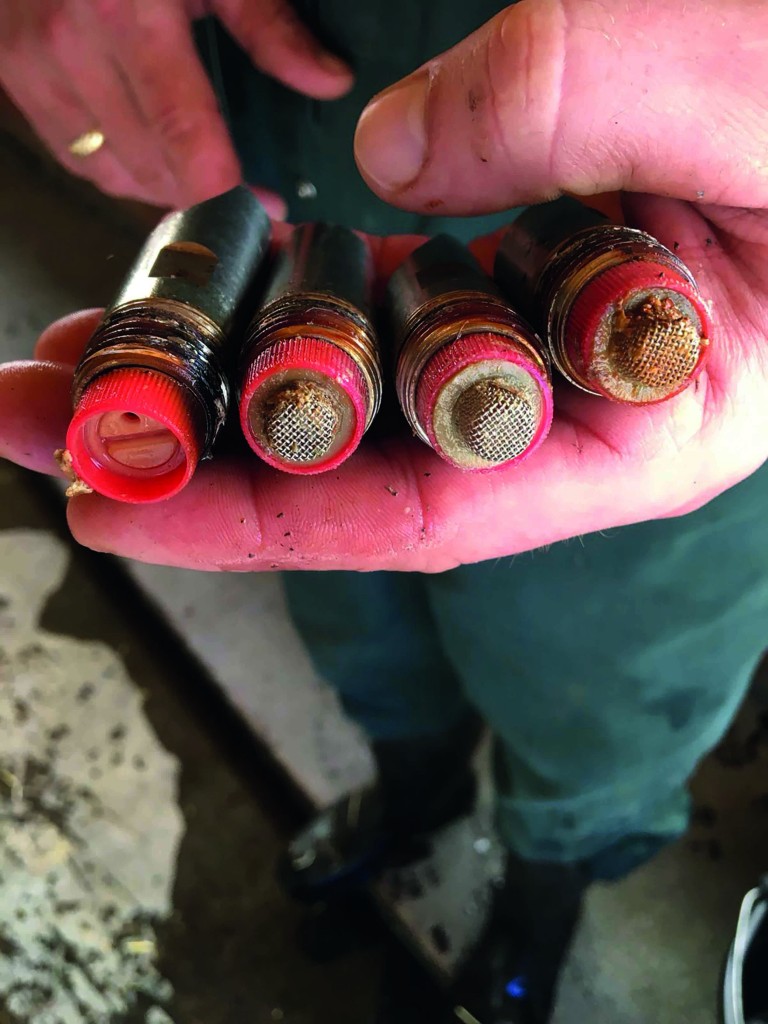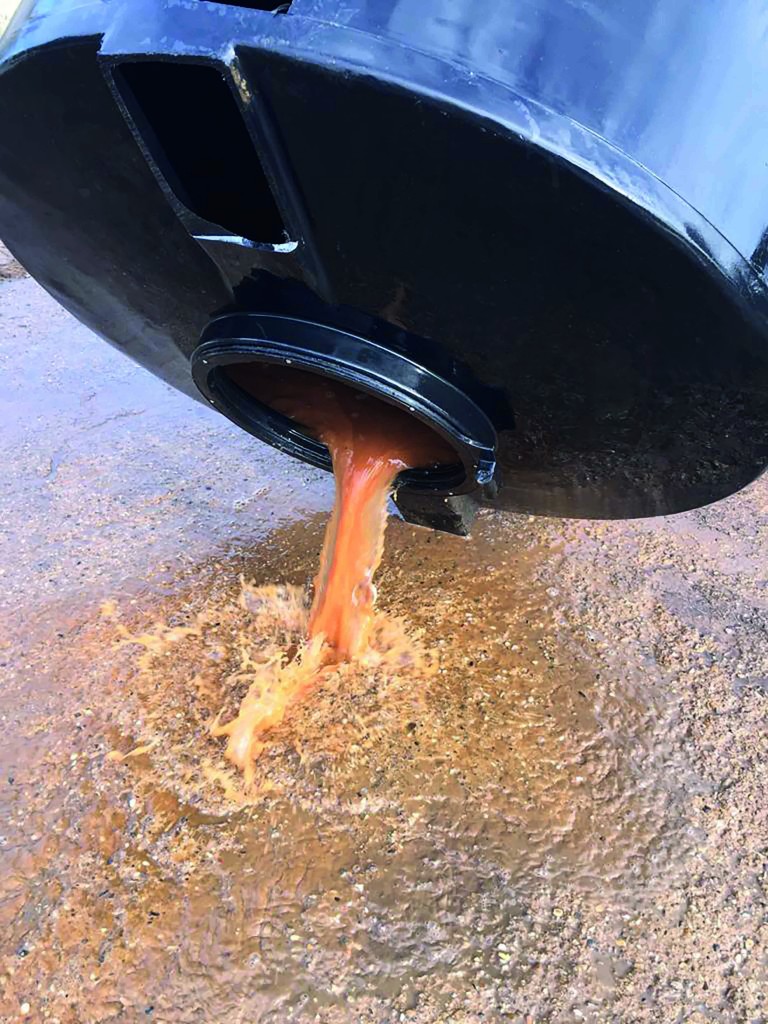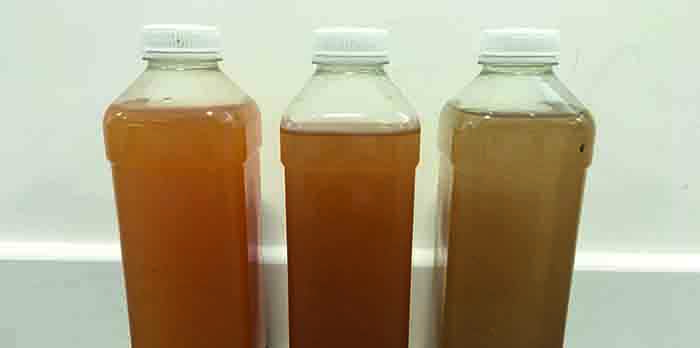The latest AHDB Strategic Farm analysis outlines why producers should not assume water is clean at the drinker
A second look at water hygiene by one of AHDB’s Strategic Farmers has yielded some unexpected results. As one revelation has led to another, they have been able to make changes that have improved both the quality and amount of water their pigs are drinking. Now they are monitoring how far this might affect health, welfare, growth and costs.
The team at the Strategic Farm had already put measures in place to keep its water system clean. They included a shock cleaning treatment between batches in the straw-based finisher sheds, where the pigs were growing well. However, once they uncovered what was in the pipework, right through to the last drinker, it was clear there was more they could do to improve the pigs’ water supply. The staff were shocked by the amount of ‘gunk’ (biofilm and sediment) that had built up over time in the pipes, filters and nipples.
A combination of correct shock treatment with a cleaning product, along with a physical cleanout of pipework and header tanks at the farm has, so far, significantly improved both the water quality and the flow rates.

SIMPLE MEASUREMENTS
With AHDB’s help, the farm began by sampling the water before and after the shock cleaning treatment it carries out between batches. They tested water before it entered the unit and, importantly, from the drinkers too.
The finishing manager said: “The water quality was fine at both the source and the drinkers at the beginning of the first batch, but started to get worse towards the end of the batch.
“So we reviewed the shock cleaning and found we had been using more of the product than we actually needed but not leaving it in for long enough.
“Having a step-by-step guide and help from AHDB has helped us switch to a new shock treatment routine between batches.”
The shock cleaning treatment involves draining the system completely, then filling the system with fresh water and adding in an approved product for the recommended time period, usually at least 24 hours. Then it is flushed through the water lines, by putting tent pegs through the nipples and draining the full tank through the system.
CLEANOUT BOOSTS FLOW RATES
Also, between batches, the AHDB team did some maintenance on the pipework and nipples. AHDB knowledge exchange manager Andrew Palmer said: “We took everything apart and cleaned the system rigorously. We took all the nipples off and soaked them in buckets overnight because debris had built up inside them.
“This thorough system cleanout was initially about reducing Total Viable Count (TVCs), a test for water quality. But when we put pegs in all the nipple drinkers at once, imitating peak drinking time, we also saw the flow rates weren’t as high as they could be. There were some blocked and ineffective nipples.
“Once the debris and residue was removed, the flow rates improved significantly throughout the system.”

HEADER TANKS
In the water storage tanks in the pens they found the outlet pipes were above the baseline of the tank so there was an amount of debris left at the bottom after the tank had been drained.
Mr Palmer said: “We power washed the tanks out and fitted full dump valves to the bottom of them so they could be completely emptied. Taking tanks down to clean is difficult on a lot of farms because of the accessibility. They’re often high up and there are health and safety implications. But it
is hopefully only a once-a-year job to bring down the tanks, pressure wash them and then put a lid on them. Future annual cleans should then be much easier.
“We’re now ready to take the third set of water samples and hopefully the results will show more consistent water quality all the way through to the end of this latest batch.”

METERING DEVICE
The Strategic Farm also found that a metering device, used to put in medication, was affecting the flow rate in one of the buildings.
The farm manager said: “We’ve temporarily taken the metering device out and the flow rates have improved, but we want to go back and re-design the water supply in that building to make sure flow rates aren’t affected if we want to put the metering device back in.”
GROWTH RATES, FCRS, WELFARE
They will now be comparing the health, growth rates and FCRs of different batches, from before and after the improvements in water quality and flow rates.
There’s also the possibility of an impact on pig behaviour and aggression. The farm manager said: “Even before we had the water quality results back for the batch after the big clean out, we noticed the pigs seemed less agitated and easier to manage.”
Mr Palmer said: “While it’s only anecdotal and there are other factors that could also be helping reduce aggression, it’s something we’ll look into further. Like any species, if you get dehydrated, you’re going to get a bit cranky. If the time spent observing or treating pigs could be reduced, then it could pay back the extra time spent cleaning the water system. Water is something that not many people give much thought to and it’s a fairly simple thing to keep right once you’ve got the basics in place.”
As they’ve found on this farm, there are often a number of lower-cost changes that can make a difference, using staff time and labour as opposed to buying brand new pipework and systems.
TOP TIPS
There are six key points the team at the Strategic Farm has highlighted so far:
If you’re confident it’s clean, check again
Even if you’re fairly confident your water is clean enough and the flow rates are right for every pig, it is definitely worth testing to check – for both mains supply and borehole water.
Test water at the drinkers
Test water at the point of drinking as well as the source, as low TVCs from samples taken at entry to the unit do not guarantee that they will remain low at the drinker.
Use cleaning products correctly
Review any water system cleaning process to make sure product quantity and the way it is used are correct/ optimal, keeping up to date with product manufacturers’ instructions.
Dismantle and clean pipework
It’s worth dismantling the system and thoroughly cleaning out water tanks, pipework and nipples, at least on an annual basis, if not between batches – and putting a lid on the tanks.
Check whether metering devices affect flow rates
If fitting metering devices, check they will work within the existing system design, so as not to affect flow rates.
Meet peak drinking time demands
Make sure the system delivers the right quantity of water throughout the day, including at peak drinking times.
More information:
Comprehensive guidance on water quality and quantity is available HERE.
Download the AHDB podcast, featuring Andrew Palmer chatting about the Strategic Farm, and Mark Jagger of Tulip and Zanita Markham from AHDB’s environment and buildings team talking about water and medication HERE. It can also be found on podcast apps, where listeners can subscribe to future AHDB podcasts.




